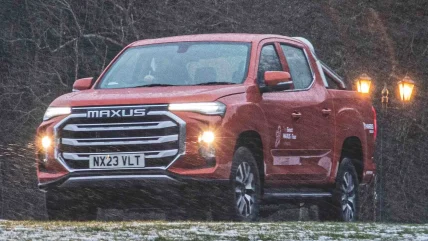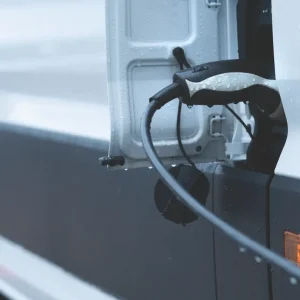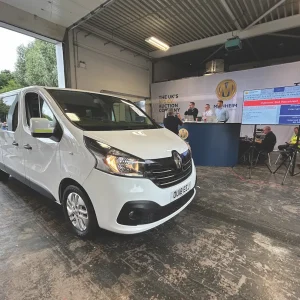
Here we go again… The TV news says work from home – not an option for everyone – and don’t make any unnecessary journeys. With diesel at this price, who is ever making ‘unnecessary’ journeys? None of that applies to you if you have a van for your livelihood, then you have to drive it for your livelihood, so let’s take a pragmatic approach and comfort in watching the ‘Anywhere Outside London Correspondent’ doing their piece to camera in a blizzard.
The vehicle
It’s cliché time first of all. Make sure your vehicle is in top condition for the winter. Consider taking advantage of your local garage or main dealer offering winter checks. If not, do your own. Make sure the anti-freeze is up to scratch – leave a bottled sample of it in the freezer overnight – likewise, screen wash, cost-option electrically heated washer jets are no good if the stuff just freezes as it hits the glass. All big gains for little effort. We used to extend the length of the pipe from screen wash reservoir to the jets and wrap several turns around a radiator hose – not as easy in today’s encapsulated engine bays. Stock up on de-icer spray too. Don’t pour a kettle of even moderately warm water on the screen, the shock it gives to the glass is almost as big as the shock you’ll get when the replacement’s invoice arrives.
Tyres come next, correct the pressures for the ambient temperature. What shows 30 psi in July won’t now. Myths abound on juggling pressure for grip, it works for sand, not ice. Ignore them all. Better to replace tyres nearing the end of their life and get the deeper tread fitted for winter. Consider replacing them with all-season / all-climate tyres – well worth the extra money. The ‘tyre sock’ is a highly effective alternative. Cheap, quick to use and easy to store. If your sat-nav has Eco-route, use that. To an extent it avoids steep hills and goes a slightly flatter (longer) way around, possibly avoiding bottlenecks of stranded vehicles.
Assault on battery
Traditionally the biggest problem on a freezing morning was the battery – batteries hate cold and you might have had trouble starting the engine. In an EV, the battery is the engine. Expect a much-reduced range for an electric van in winter.
For a start, the Worldwide Harmonized Light Vehicles Test Procedure (WLTP) is simply not fit for purpose. It is carried out in a laboratory at 23-degrees Centigrade (considered optimal for BEVs), the acceleration phase of the test is equal to getting from 0-60mph in longer than 20 seconds and the average speed across the whole test is just 29mph. So you are highly unlikely to ever get near the claimed range – but in winter it gets much worse. Manufacturers will not quote figures but my own small EV car offers a yardstick of sorts. Its official (WLTP) range is 140 miles, if I drive it in the same manner with which I can return slightly better than the official mpg for a diesel van on roadtest, in ambient temperatures above 15-degrees Centigrade, it will give around 120 miles or 85% of official range. In freezing temperatures that plummets to 75 miles – just 53%! Most BEVs have a pre-heater system, it not only warms the cab and de-frosts the windows but pre-conditions (warms) the battery. Always use it if you can, particularly with the van plugged in, where there’s no loss to maximum range. Once underway, heated seats take less energy than the heater itself, ditto an electrically heated windscreen clears more economically than the heater and fan on full blast.
The driver
Let’s stick with the EV for now and all the basic adages still apply to driving an EV in snow as for a diesel van, Use all the controls gently and progressively and look well ahead to anticipate. Just setting off is the first issue. Electric motors generate full torque instantly from ‘zero’ rpm. You cannot move off in second gear to limit the torque, you can’t slip the clutch to reduce it further. Only the traction control system can help. Some EVs can be set to ‘creep’ – like an automatic – rather than ‘hold’, – the creep mode might just ease you away better. Always switch on any, snow/trail / slippery modes if available, they do actually make a difference. Next comes regenerative braking.
In my small EV again, jump off the accelerator at 30 mph and it comes to a complete stop in 30 metres without touching the brake – would you choose to brake that hard on snow or ice? So, go for the lesser amount of regen if selectable, (and don’t switch to ‘B’) it’s more akin to easing off the accelerator in a diesel manual van, applying the brakes will affect a regen anyhow, then it’s down to ABS and ESP systems like any other van. Old adages apply once more, take it slow, plan ahead and avoid making those systems work.
Freshly fallen snow actually offers reasonable grip, hard compacted stuff is skating rink standard. For the most part follow in the tyre tracks of those ahead – unless their wheelspin has polished it, in which case you may fare better straddling the tracks and seeking soft fresh snow – especially if tyre socks are fitted. It’s the same for braking, deep soft snow offers more retardation simply due to its resistance.
If you get stuck, take time to think, don’t spin the wheels once it’s clear the traction control is not coping. If on a slope, handbrake on, in ‘P’ and make sure the vehicle is not going to move before getting out. On the flat, shovel snow away from the front-driven wheels and a little ahead, to get a bit of a run-up. On a rear-drive vehicle or 4×4 you’ll need to clear away snow ahead of all wheels. On a hill, shovel behind the driven wheels and roll back onto the cleared road. Either way, use plenty of acceleration on the short cleared section but consider the speed you’ll have once back on the slippery stuff.
Next, consider what’s hidden beneath, it could be ice, it could be tyre-damaging debris, so delving into the deeper snow is not always the answer. Moreover, all the road markings are hidden. The Give Way sign is deliberately upside-down so you can recognise it when covered in snow, so why do so many T-junctions in the UK have the triangle painted on the road surface with no sign? Look for the back of other signs to give an indication, a single streetlamp will often be opposite the mouth of a T-junction.
An invisible enemy is black ice, a bit of a generic term it’s generally caused by rain freezing on the already cold surface. Hard to see and difficult to deal with. Observe the oncoming traffic too, why is it so slow out of an innocuous-looking bend? Multiply your following gap on the vehicle ahead by ten-fold compared to a dry road.
Low sun is actually one of the greatest winter hazards and probably accounts for more single-vehicle crashes than any amount of ice or snow. Be aware of the sun’s position and angle and anticipate if it will suddenly reappear, reduce your speed far more than the bend alone would dictate Daytime running lights on vehicles help you see oncoming traffic at least, if you don’t have them, use dipped beam headlamps all day.
While we’re talking about visibility, let’s consider fog. There’s no clever trick to dealing with fog except to drive slowly enough for the braking distance seen ahead. That in itself is probably the hardest task. It is so deceptive and our natural trait is to look for a reference point ahead. Unfortunately that is usually the leading vehicle and we naturally draw towards it. Try to drop back until you can only just see its rear fog lights, rather than close up and use it as a pathfinder. Try to look for unlit reference points at the roadside to judge your speed and the density of the fog. At night it is much worse. Slow is the only answer – at least it will extend your EV range!





